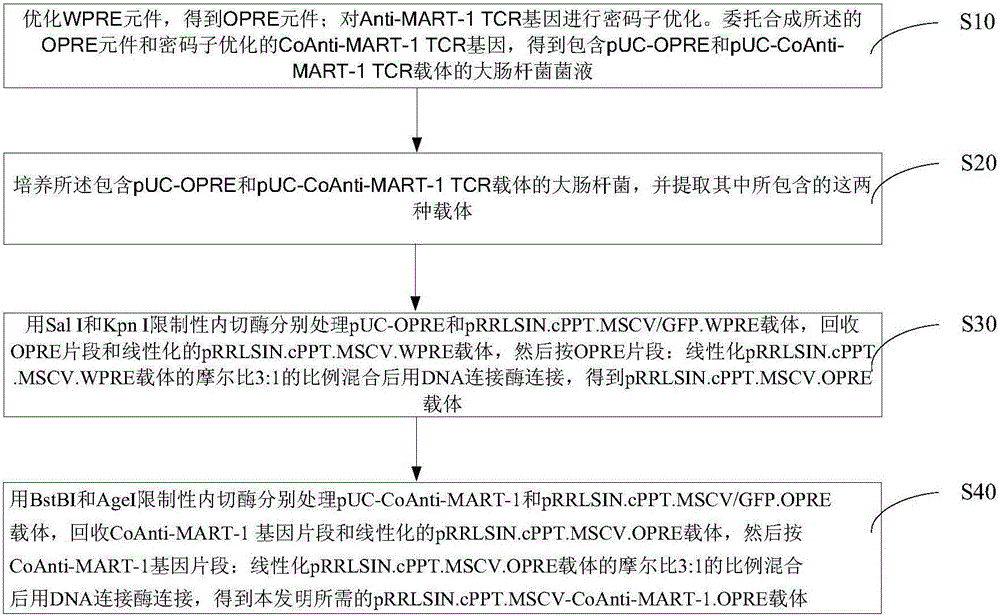Preparation and application of safety-improved lentiviral vector for expressing codon-optimized Anti-MART-1 TCR gene
A technology of lentiviral vector and codon optimization, which is applied in the direction of virus/bacteriophage, retroRNA virus, and the introduction of foreign genetic material by vector, which can solve the problems of limited use, complicated separation process, and suboptimal effect, etc., and achieve improvement Safety, Growth Inhibition, Survival Prolongation Effect
- Summary
- Abstract
- Description
- Claims
- Application Information
AI Technical Summary
Problems solved by technology
Method used
Image
Examples
Embodiment 1
[0041] The transformation of embodiment one WPRE sequence
[0042] Since WPRE has a potential promoter and part of the X protein sequence, these two parts need to be deleted. Select the fragment at the 901-1482bp position of the DNA sequence of the woodchuck hepatitis virus post-transcriptional regulatory element, and mutate the potential start codon (ATG) in it to obtain the OPRE fragment, such as figure 1 Shown, its nucleotide sequence is shown in SEQIDNo.:1. Commissioned Shanghai Sangon Bioengineering Co., Ltd. to synthesize the OPRE element, and used the pUC57 vector as a subcloning vector in the gene synthesis service to obtain the pUC-OPRE vector.
Embodiment 2
[0043] Embodiment 2 Transformation of pRRLSIN.cPPT.MSCV / GFP.WPRE vector
[0044] Treat the pUC-OPRE vector and the pRRLSIN.cPPT.MSCV / GFP.WPRE vector with SalI and KpnI endonucleases, respectively recover about 300bp of the OPRE sequence and about 6800bp of the pRRLSIN.cPPT.MSCV / GFP.WPRE vector fragment, and then convert the OPRE The sequence was mixed with the pRRLSIN.cPPT.MSCV / GFP.WPRE vector fragment at a molar ratio of 3:1 and ligated with DNA ligase. After the ligation was completed, the SalI and KpnI endonucleases were used for enzyme digestion and identification, and the ligation products of about 500bp fragments could be successfully digested and sent to Shanghai Sangon Bioengineering Co., Ltd. for sequencing. The correct sequencing result is the pRRLSIN.cPPT.MSCV / GFP.OPRE vector, whose structure is as follows figure 2 shown.
Embodiment 3
[0045] Example 3 Packaging of lentivirus
[0046] Cultivate 293FT cells, take cells in good growth state and inoculate them into 10cm culture dishes, each dish is inoculated with 5×10 6 After adding DMEM without double-antibody medium to culture the cells for about 18 hours until the fusion degree reaches 80-90%, take 10 μg of lentiviral vector, 5 μg of auxiliary vector pMDLg / pRRE, pRSV-Rev and pMD-G vector, and use Lipofectamine 2000 to transfer Induced into 293FT cells, 4-6h after transduction, replaced with DMEM complete medium. After 48 hours, the virus-containing supernatant culture medium was collected, centrifuged at 6000g for 10 minutes, and the supernatant was taken and then filtered with a 0.45 μm filter head to obtain a lentivirus solution.
PUM
 Login to View More
Login to View More Abstract
Description
Claims
Application Information
 Login to View More
Login to View More - R&D
- Intellectual Property
- Life Sciences
- Materials
- Tech Scout
- Unparalleled Data Quality
- Higher Quality Content
- 60% Fewer Hallucinations
Browse by: Latest US Patents, China's latest patents, Technical Efficacy Thesaurus, Application Domain, Technology Topic, Popular Technical Reports.
© 2025 PatSnap. All rights reserved.Legal|Privacy policy|Modern Slavery Act Transparency Statement|Sitemap|About US| Contact US: help@patsnap.com



